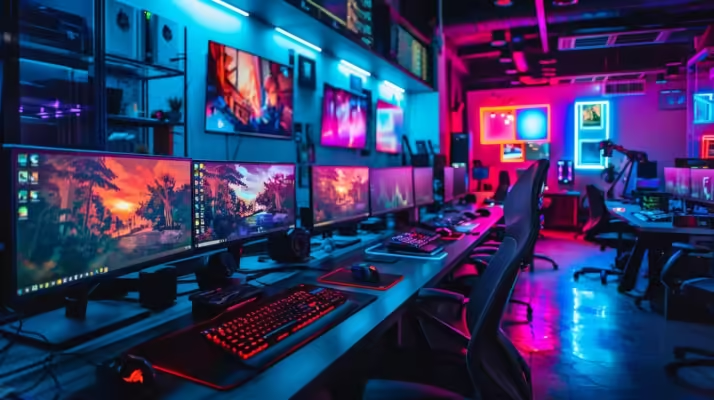What is a Gaming Room?
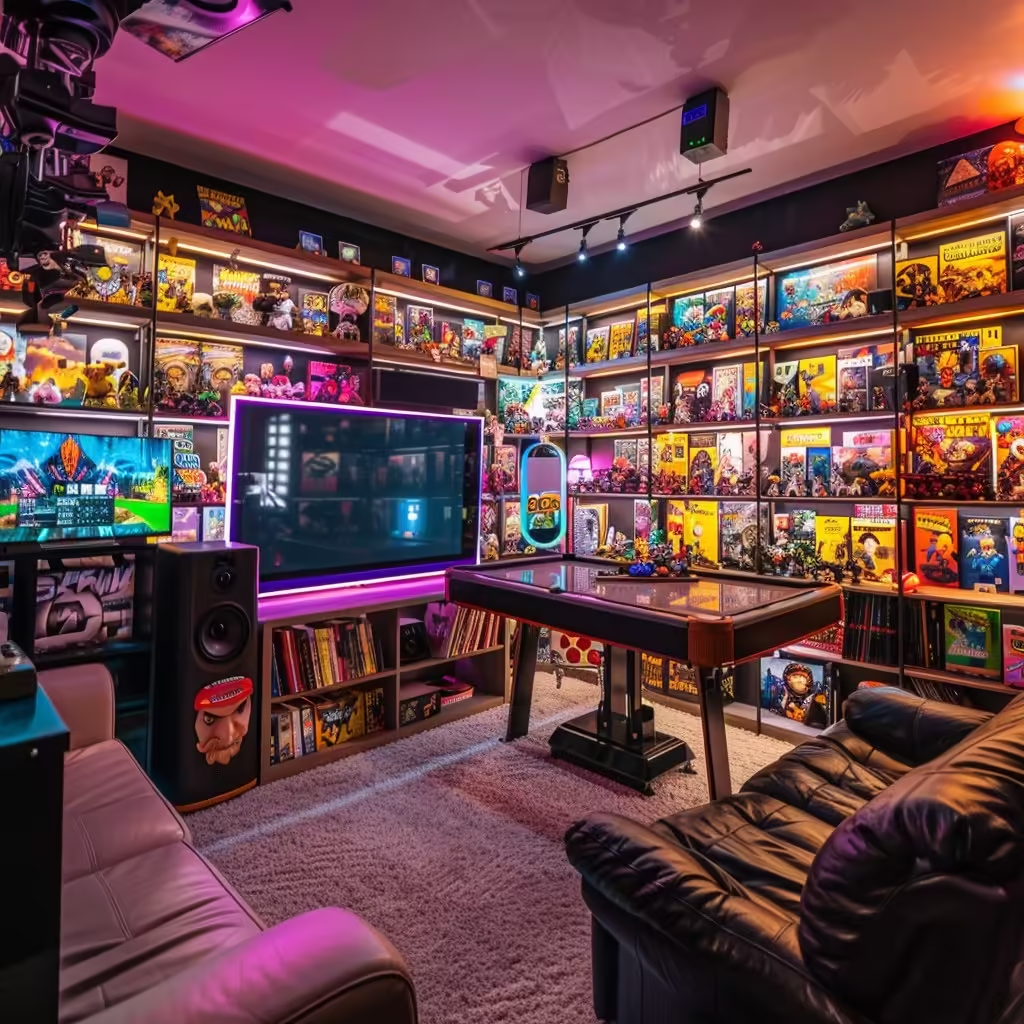
A gaming room is a dedicated area in your home specifically designed to enhance the gaming experience. Unlike a living room or bedroom where gaming might be a secondary activity, a gaming room is tailored to meet the needs of gamers, ensuring comfort, performance, and immersion.
The room is typically equipped with gaming consoles, high-performance PCs, ergonomic furniture, specialized lighting, and decor that aligns with the gamer’s preferences. The goal is to create an environment where you can fully engage in gaming without distractions or discomfort.
Essential Components of a Gaming Room

Creating an ideal gaming room requires several key components, each contributing to the overall experience:
Gaming Console or PC:
This is the centerpiece of your gaming room. Depending on your preference, you might have a high-end gaming PC, a PlayStation, Xbox, Nintendo Switch, or even multiple systems. The choice of platform influences the type of games you can play, the visual quality, and the accessories you’ll need.
Monitors and Screens:
The display is crucial for immersive gaming. High-quality monitors or TVs with low response times (ideally below 5ms) and high refresh rates (120Hz or more) are essential. Multiple monitors can enhance gameplay, especially for PC gaming, where having additional screens can be beneficial for multitasking or streaming.
Gaming Chair and Desk:
Comfort is key, especially for long gaming sessions. An ergonomic gaming chair supports your posture, reduces strain, and can prevent back pain. Seek out chairs with lumbar support, plush padding, and height adjustment. The desk should be spacious enough to hold your monitors, keyboard, mouse, and other accessories. It should also be at a height that prevents strain on your wrists and arms.
Sound System or Headphones:
A big component of the game experience is the audio. A surround sound system can create an immersive environment, making you feel as though you’re in the game. However, high-quality gaming headphones can be just as effective, especially if you’re playing in a shared space or late at night.
Lighting:
Proper lighting can enhance the gaming experience by setting the right mood. RGB lighting is popular for gaming rooms, as it allows you to change colors to match the game or your mood. Ambient lighting behind monitors or around the room can reduce eye strain and make the space more visually appealing.
Storage and Organization:
A cluttered gaming room can be distracting and reduce your enjoyment. Invest in shelving, cable management solutions, and storage units to keep your space organized. This helps in keeping your gaming area neat and ensures that all your equipment is easily accessible.
Gaming Room Ideas for Different Spaces

Whether you have a small corner or a large room, you can create a functional and enjoyable gaming space:
Small Room Setup:
In a small room, every inch counts. Opt for compact furniture that fits the space without making it feel cramped. Wall-mounted monitors or TVs can save desk space. Consider using floating shelves for storage and choosing a desk with built-in storage compartments. Foldable furniture or multi-purpose items, like a desk that doubles as a storage unit, can also be useful.
Large Room Setup:
If you have a larger room, you can afford to get creative with your layout. Consider setting up multiple gaming stations, especially if you have friends or family who game with you. You can create separate areas for different activities, such as a dedicated console gaming area, a PC gaming station, and a lounge area with comfortable seating for watching streams or playing casual games.
Shared Space:
If your gaming room doubles as a home office or entertainment room, it’s important to strike a balance between functionality and gaming aesthetics. Consider using furniture that suits both purposes, like a desk that’s big enough for work and gaming. Use carpets or room dividers to create a visual barrier between spaces.For example, a cozy gaming corner can be created with a plush rug, comfortable chair, and ambient lighting, distinct from the work area.
Designing Your Gaming Room Setup

The layout and organization of your gaming room can greatly impact your comfort and performance. Here’s how to design an optimal gaming room setup:
Layout:
Start by planning the layout of your room. Consider the placement of your gaming station in relation to power outlets, windows (to avoid glare), and the room’s natural traffic flow. Ensure that your main seating position is at a comfortable distance from your screen(s). If you’re setting up multiple gaming stations, arrange them so that players don’t interfere with each other’s space.
Furniture Placement:
Your desk and chair should be positioned to minimize strain. The desk should be at a height where your arms rest comfortably while typing or using a mouse. The chair should be positioned so that your eyes are level with the top of your monitor, reducing the need to tilt your head. Ensure that your setup allows for good posture, with your feet flat on the ground and your back supported.
Cable Management:
If cables are not properly managed, they can rapidly become a tangled mess. Use cable organizers, clips, or sleeves to keep them tidy and out of sight. If possible, run cables along the back of furniture or under carpets to keep them out of the way. Good cable management not only improves the look of your gaming room but also reduces the risk of tripping or damaging your equipment.
Gaming Room Decor: Personalizing Your Space
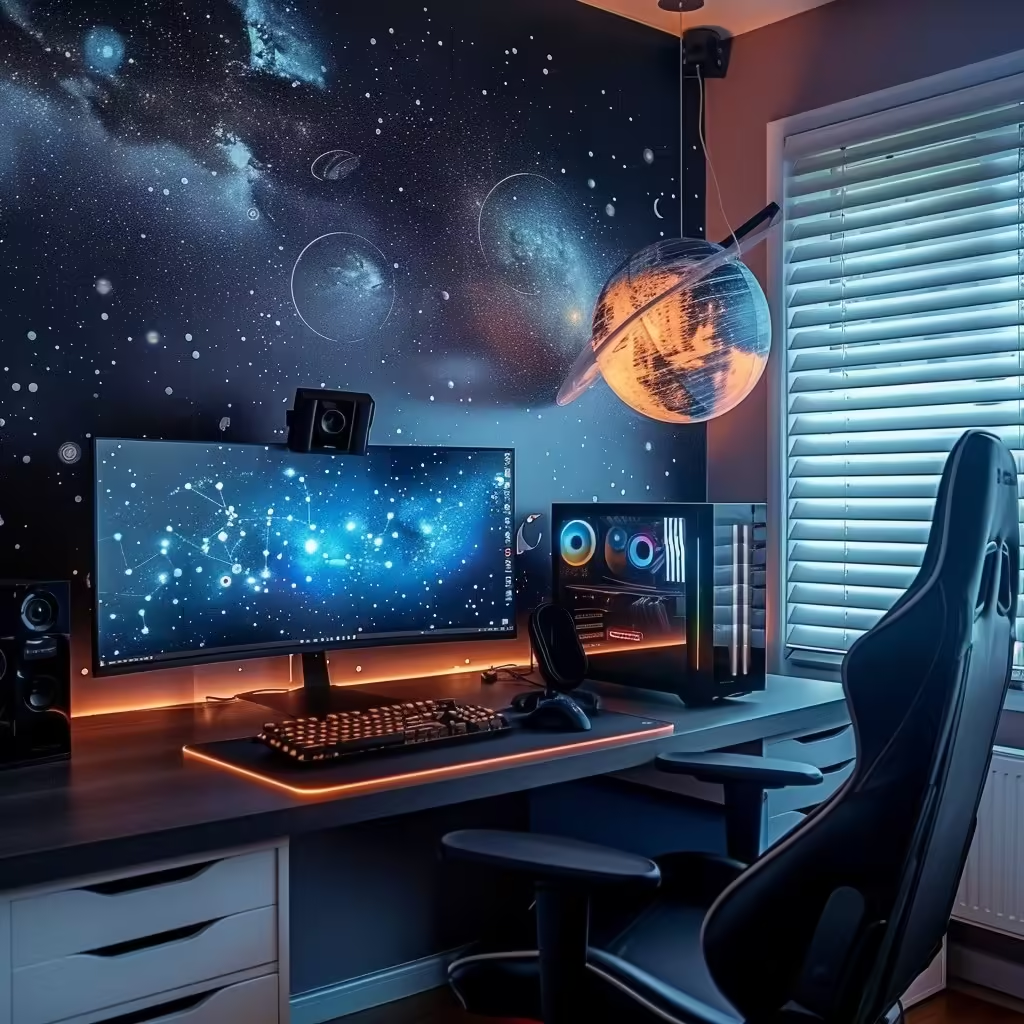
Your gaming room is an extension of your personality, and the decor is where you can truly express your unique style:
Wall Art and Posters:
Decorate your walls with artwork that reflects your gaming interests. This could be posters of your favorite games, framed concept art, or even custom wall decals. You can create a gallery wall with a mix of game-related art, adding a personal touch to your space.
Themed Furniture:
If you’re a fan of a particular game or genre, consider themed furniture that aligns with that interest. For example, a racing-themed gaming room might feature a racing-style gaming chair, checkered flooring, and memorabilia from racing games. For a fantasy-themed room, you could incorporate medieval-style furniture and fantasy artwork.
Lighting Effects:
Your gaming room’s vibe can be drastically altered by the lighting.RGB lighting is popular because it allows you to customize the color and intensity of the lights. You can sync the lighting with your games or music for a dynamic effect. Consider using LED strips around your desk, behind your monitor, or along the walls to create a futuristic or immersive atmosphere.
Collectibles and Memorabilia:
Showcase your love for gaming by displaying collectibles, action figures, or special edition consoles. You can use shelves, display cases, or shadow boxes to organize and highlight these items. This not only adds a personal touch but also makes your gaming room feel like a curated space.
Creating a Bedroom Gaming Room

If space is limited, setting up a bedroom gaming room might be the best option. Here’s how to integrate a gaming setup into your bedroom without compromising comfort:
Space-Saving Furniture:
Choose furniture that maximizes space. A foldable desk can be stored away when not in use, freeing up floor space. Wall-mounted TVs or monitors save desk space and create a cleaner look. Consider a loft bed with a gaming setup underneath, which can be a great solution for small rooms.
Multi-Functional Setup:
Integrate your gaming setup with existing bedroom furniture. For example, use a dresser as a TV stand or choose a desk that doubles as a vanity. This allows you to maintain a cohesive look in the room while still having a dedicated gaming area.
Privacy and Comfort:
Ensure your gaming setup doesn’t interfere with your sleep. If possible, separate your gaming area from your bed with a room divider, curtain, or by positioning your bed away from the gaming station. Use soft lighting that can be dimmed for late-night gaming without disturbing your sleep environment.
The Importance of Ergonomics in Your Gaming Room
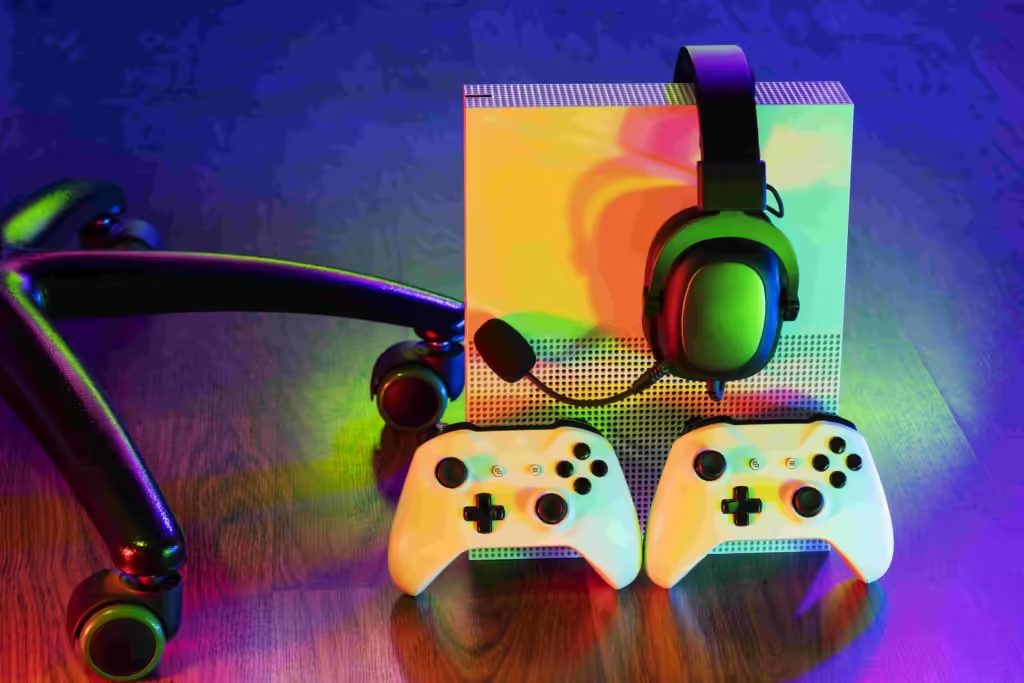
Ergonomics is crucial for maintaining comfort and health during long gaming sessions. Here’s how to ensure your gaming room is ergonomically sound:
Chair Selection:
Your chair should support your spine’s natural curve, with adjustable features to fit your body. Look for a chair with lumbar support, adjustable armrests, and a reclining feature to relieve pressure on your back. The seat should be deep enough to support your thighs but not so deep that it pushes you away from the backrest.
Desk Height:
Your desk should be at a height where your arms form a 90-degree angle when typing or using a mouse. If your desk is too high, it can cause shoulder strain; if it’s too low, it can lead to hunching. Consider using an adjustable desk to find the perfect height for you.
Monitor Positioning:
Make sure the top of the screen on your display is at or slightly below eye level.This prevents you from tilting your head up or down, which can cause neck strain. The monitor should be about an arm’s length away from your eyes to reduce eye strain and allow you to see the entire screen without moving your head.
Acoustic and Lighting Considerations for Your Gaming Room

Sound and lighting are key elements that can enhance or detract from your gaming experience. Here’s how to optimize both:
Acoustic Treatment:
Good acoustics can make a huge difference in your gaming room. Soundproofing the room helps block out external noise and keeps your gaming noise from disturbing others. You can use acoustic panels, thick carpets, and heavy curtains to absorb sound and reduce echo. If you’re serious about sound quality, consider adding a subwoofer and strategically placing speakers around the room for a true surround sound experience.
Lighting Setup:
Avoid harsh overhead lighting, as it can cause glare on your screens and strain your eyes. Instead, opt for ambient lighting that illuminates the room without causing reflections. Task lighting, such as desk lamps or LED strips, can provide focused light where you need it. You can also use smart bulbs that allow you to adjust the color and brightness to suit your mood or the game you’re playing.
Popular Gaming Room Themes

A themed gaming room can add a unique and personal touch to your space. Here are some well-liked themes to think about:
Futuristic:
This theme is characterized by sleek, modern furniture, metallic accents, and neon or LED lighting. Think of a spaceship or cyberpunk-inspired setting with minimal clutter, high-tech gadgets, and a clean, streamlined look.
Retro:
A retro gaming room brings back the nostalgia of classic arcade games and vintage consoles. Bold colors, neon signs, and vintage posters create a fun, lively atmosphere. You might include retro arcade machines, pixel art, and even old-school gaming consoles like the NES or Sega Genesis.
Minimalist:
If you prefer a clean, clutter-free environment, a minimalist theme might be for you. This design focuses on simplicity, with neutral colors, sleek furniture, and a focus on functionality. The key is to keep only the essentials in your gaming room, reducing distractions and creating a calm, organized space.
Technology Integration in Your Gaming Room

Incorporating the latest technology can elevate your gaming experience and add convenience to your setup:
Integrating smart home devices into your gaming room can automate many aspects of your space. Use voice commands or smartphone apps to control your lighting, adjust the temperature, or even turn on your gaming setup. Smart plugs, lights, and thermostats can make your gaming room more efficient and personalized.
Virtual Reality (VR):
If you’re into VR gaming, creating a dedicated VR space in your gaming room is essential. Ensure there’s ample room for movement, with clear floors and minimal obstructions. You may want to install wall-mounted sensors or cameras to track your movements, and consider padded flooring for comfort and safety.
Advanced Cooling Systems:
High-performance gaming equipment generates heat, which can affect both your comfort and the longevity of your hardware. Consider installing advanced cooling solutions, such as liquid cooling for your PC, additional fans, or even air conditioning units designed for small spaces. Keeping your gaming room cool will improve performance and prevent overheating.
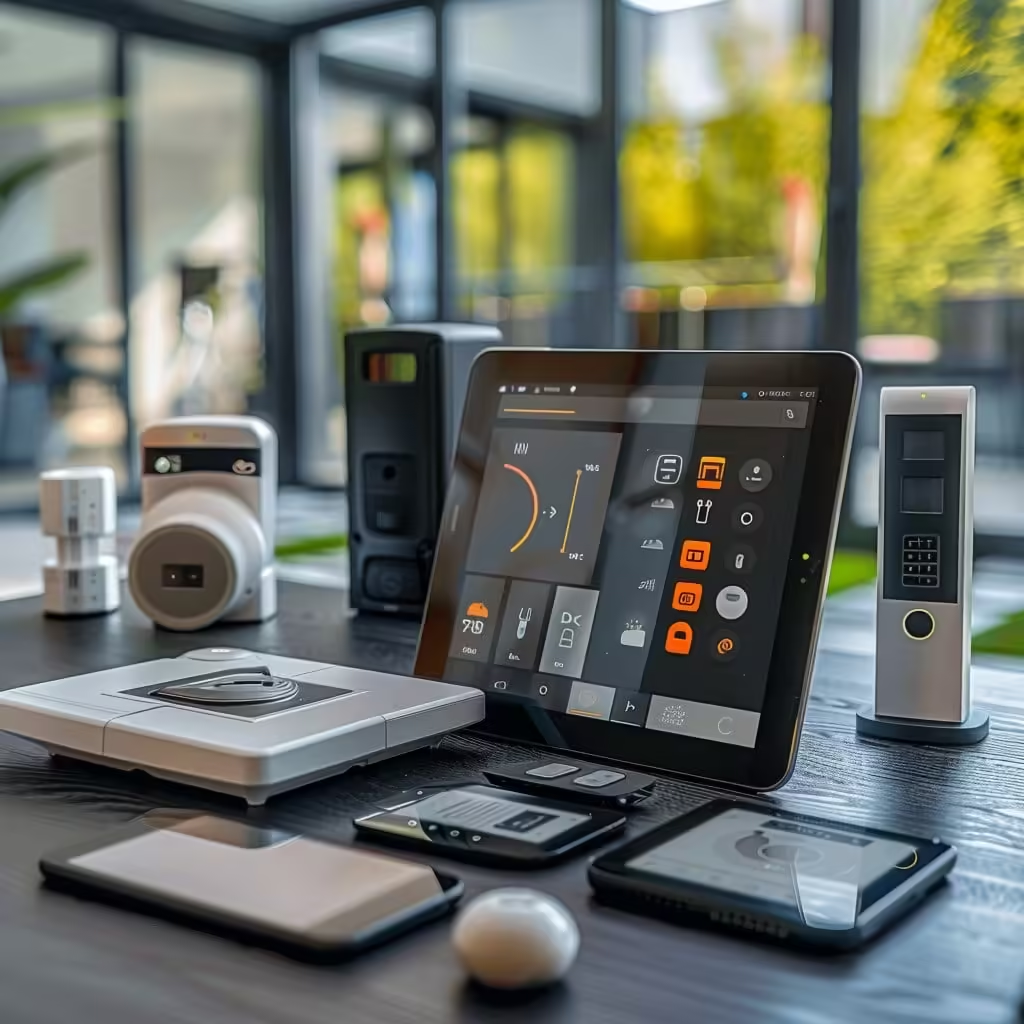
Case Studies: Inspirational Gaming Room Setups
Looking at real-world examples can provide inspiration for your gaming room design. Here are some notable setups:
The Ultimate PC Gaming Room:
This setup might feature multiple high-end gaming PCs, ultra-wide monitors for immersive gameplay, and a dedicated streaming station with professional-grade microphones, cameras, and lighting. The room might include RGB lighting synced with the game’s action, ergonomic furniture for comfort during long streams, and acoustic panels for clear audio.
The Themed Console Room:
A gaming room themed after a popular game or series can create an immersive environment. For example, a room inspired by “The Legend of Zelda” might feature forest-green walls, Triforce wall art, and a custom-built gaming console resembling the Master Sword. Themed furniture, such as a Hylian Shield chair or Ocarina of Time wall clock, could complete the look.
The Budget-Friendly Gaming Nook:
For gamers on a budget, a well-thought-out gaming nook can provide a great experience without breaking the bank. This setup might include a budget-friendly gaming chair, a single monitor on a simple desk, and creative use of existing furniture. DIY projects, like custom-built shelves or repurposed storage units, can add personality without the cost.
Conclusion
Designing the perfect gaming room is a deeply personal project that combines functionality, comfort, and style. Whether you’re working with a large dedicated space or a small corner of your bedroom, the key is to create an environment that enhances your gaming experience and reflects your unique tastes. From ergonomic setups to themed decor, every detail matters in making your gaming room the ultimate escape.
Frequently Asked Questions
1. What is the ideal size for a gaming room?
The ideal size for a gaming room depends on your available space and gaming needs. For a single gaming setup, a small room or even a corner of a larger room can suffice. If you want multiple gaming stations or a more immersive experience with VR, a larger space of 10×12 feet or more is recommended.
2. How much does it cost to set up a gaming room?
The cost of setting up a gaming room can vary widely depending on the quality of equipment and furniture you choose. A basic setup might cost between $500 to $1,500, while a more advanced or themed gaming room can cost upwards of $5,000 or more.
3. What are the essential components of a gaming room?
Essential components include a gaming console or PC, monitors or a TV, an ergonomic gaming chair, a sturdy desk, a sound system or headphones, Gaming Keyboards, proper lighting, and storage solutions. Optional components might include themed decor, smart home devices, and advanced cooling systems.
4. How can I make my gaming room more comfortable?
To increase comfort, invest in ergonomic furniture like a high-quality gaming chair and an adjustable desk. Ensure good cable management to reduce clutter, use ambient lighting to reduce eye strain, and consider soundproofing to create a quiet, immersive environment.
5. What are some popular themes for a gaming room?
Popular themes include futuristic designs with sleek furniture and RGB lighting, retro setups with vintage gaming consoles and neon signs, and minimalist rooms that focus on simplicity and functionality. Themed rooms based on favorite games or genres are also popular.
6. How do I incorporate VR into my gaming room?
To incorporate VR, ensure you have enough clear space for movement. Install wall-mounted sensors or cameras if your VR setup requires them, and consider padded flooring for safety. A dedicated area for VR can enhance the experience and prevent accidents.
7. What lighting is best for a gaming room?
Ambient lighting that reduces glare and eye strain is ideal for a gaming room. RGB lighting is popular because it allows for customization of colors to match your mood or game. Avoid harsh overhead lights; instead, use LED strips, desk lamps, or smart bulbs that can be adjusted for brightness and color.
8. How can I soundproof my gaming room?
To soundproof your gaming room, consider using acoustic panels on the walls, thick carpets or rugs on the floor, and heavy curtains on the windows. These materials absorb sound and reduce noise levels both inside and outside the room, enhancing your gaming experience.
9. What is the best way to manage cables in a gaming room?
Good cable management can be achieved with cable organizers, clips, or sleeves. Run cables along the back of furniture or under carpets to keep them out of sight. Use cable ties to bundle cables together and prevent tangling.
10. Can I set up a gaming room in my bedroom?
Yes, you can set up a gaming room in your bedroom. Choose space-saving furniture, like wall-mounted monitors or foldable desks, and create a multi-functional setup that doesn’t interfere with your sleep. Use soft lighting and consider a room divider to separate the gaming area from the rest of the bedroom.
11. How can I create a budget-friendly gaming room?
For a budget-friendly gaming room, focus on essential components and consider DIY solutions for decor and storage. Opt for a single monitor setup, use existing furniture, and look for sales or second-hand items to save money. Personalize the space with affordable posters, lighting, and accessories.
12. What technology should I integrate into my gaming room?
Consider integrating smart home devices for lighting and temperature control, VR equipment for immersive gameplay, and advanced cooling systems to keep your equipment cool. Technology can enhance the convenience and functionality of your gaming room.

